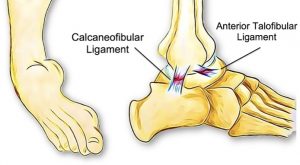CUMBERLAND PHYSIOTHERAPY PARRAMATTA: Ankle sprains are extremely common, however, this doesn’t make them easy to cope with when they happen to you. If you’ve ever spent two weeks hobbling around on crutches after an unfortunate twist, you’ll understand just how painful and difficult they can be.
What are they?
Ankle sprains refer to a tear to the ligament fibres of the ankle. Commonly, a person will roll their ankle inwards and tear the ligament on the outside. Occasionally, the ankle will twist outwards and the ligaments on the inside of the ankle are torn and even less commonly, the fibres of the ligament that hold the two bones of the lower leg together tear (high ankle sprain). A sprained ankle will usually be painful, swollen, bruised, difficult to walk on and in some cases unstable.
How does it happen?
Ankle sprains can occur from something as simple as putting weight onto your leg when you think your foot is flat even though it’s not. The most typical pattern is of a person jumping and landing on the outside of their foot or simply slipping and twisting their ankle. A sprained or twisted ankle is one of the most common injuries presented to emergency departments around the world. This is important as a severely sprained ankle can actually have very similar symptoms to a broken ankle and will need an X-ray.
A medical professional should assess any severe sprain. However, there are some guidelines to help decide if a sprained ankle needs X-ray.
1. You are unable to put weight on the ankle immediately after the injury.
2. You are unable to take more than 4 steps immediately after the injury.
3. Pain on the bony edges of the outer foot and ankle.
How long do sprains take to heal?
Depending on the severity of the tear, from one to six weeks. Your physiotherapist is able to help with recovery and ensure nothing slows down the healing. Following any injury of the body, joints may remain a little stiff and lose strength and control. Even though the injured tissues have healed, the ankle doesn’t move quite the way it used to. This means that your risk of twisting it again is higher than before the injury.
How can physiotherapy help?
Correct rehabilitation can help to prevent recurring injuries. As well as providing support to the unstable ankle, your physiotherapist will help you to strengthen any weak muscles and restore balance and control through exercise. They are also able to correct any abnormal movement of the joint following swelling.

